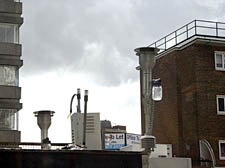|
|
 |
| |

Camden Council’s air quality monitoring station at Swiss Cottage roundabout records the area’s pollution levels |
Pollution: ‘We break the law and people know nothing about it’
New plan aims to tackle environmental crisis as health fears grow in borough choking on smog
OUR air is thick with poisons.
Camden’s skies are so rich in two of the atmosphere’s most problematic pollutants that the whole borough is considered an “air quality management area” – the government’s benign term for zones in which pollution is consistently high enough to raise health concerns.
Nitrogen oxides and “particulate matter”, both of which in high doses can damage lung tissue and exacerbate asthma and other respiratory problems, are regularly found at twice the government’s accepted levels in Camden, and pollution on the Euston Road, in Bloomsbury and around Swiss Cottage junction are among the worst in the UK.
Air quality monitoring experts based at King’s and Imperial colleges refer to “episodes” of exceptional air pollution. London’s most recent – a cold weather smog in January – was concentrated at just one monitoring site in the capital, the Swiss Cottage gyratory.
When a site flashes up red on the monitors’ maps, as it did then, the advice from health experts to those with sensitive breathing would be to stay inside.
Gas boilers and road traffic do most of the damage. “Diesel fumes are basically sending us all to an early grave and very few of us know anything about it,” said Camden’s “eco-champion” Councillor Alexis Rowell. “It’s the equivalent of a lifetime of heavy smoking. For our urban children it means their lungs never fully develop.
“But the latest evidence is that it doesn’t just lead to lung diseases like asthma. Diesel soot particles are so minute that they get into our bloodstream and cause heart diseases.”
Professor Frank Kelly, who holds the chair in Environmental Health at King’s College, was recently brought in to discuss Camden’s air quality.
He said yesterday (Wednesday): “As new information becomes available each year there is a suggestion that exposure to traffic pollution is as dangerous as exposure to cigarette smoke. In that Camden is regularly exceeding the World Health Organisation (WHO) standards and they have to work harder to reduce traffic.”
Many health experts disagree on the severity of the impact. The Health Protection Agency, the UK’s public health watchdog, say that while research is still ongoing, “long-term health effects due to air pollution are likely to be very small when compared to other things that cause ill health such as cigarette smoking, poor housing or unemployment”.
But since 1999, local authorities have been charged with monitoring air quality and striving to meet targets to reduce pollution. Year in, year out, Camden has failed these to reach targets, with the air over Swiss Cottage and King’s Cross stubbornly refusing to drop to anywhere near the standards demanded by European and UK laws.
Next week, Camden’s environment chiefs will outline a new three-year strategy for tackling the health of the air. It’s a tall order, as much of central London is similarly afflicted, and at least 40 per cent of the pollution in Camden comes from elsewhere including, under certain weather conditions, from as far as Continental Europe.
And like all boroughs, Camden has limited power to control the use of the roads by non-residents. But those living in the borough have been systematically targeted by measures intended to reduce the use of cars. Parking permit fees are now scaled proportionately to the emissions of a resident’s vehicle, while 4,050 people have joined car-sharing clubs. Every street in the borough is in a controlled parking zone, and the Town Hall claims that a rigorous enforcement regime creates a culture of limited car ownership.
Twelve off-street and five on-street plug-in points are designed to encourage electric cars.
The new strategy promises more of the same. The council’s own drivers will be trained to drive in a more eco-friendly way and its fleet of vehicles will be tailored away from damaging diesel.
New building developments will be assessed for their emissions impact, and the campaign – largely successful – to improve cycling safety will continue. Meanwhile, the council will talk to the big train companies about the diesel engines that work from King’s Cross and St Pancras.
But Green Party councillor Maya De Souza said that while any air quality efforts were welcome, the plans fell “far short of what we’d expect”.
She said: “This fails to address the huge problem of HGVs, which make up 34 per cent of nitrogen oxides and 20 per cent of particulates. We need a clear commitment to a freight consolidation centre, and we should be making sure that motorbike usage shouldn’t be encouraged. The contribution of motorcycles is almost the same as the contribution by cars.
“And we still need a radical rethink about how we get many more people to cycle.”
Cllr Rowell has a more urgent demand: “We have a terrible problem with air quality.
“We break EU law, we break WHO guidelines, and people know nothing about it. We need to alert the public to what is happening.” |
 |
|
|
 |
YOUR COMMENTS:
I lived on Finchley Road for 18 years. During that time I developed skin rashes, sore eyes, asthma and finally lung disease.I often asked the council to install anti pollution paving stones as have been trialed in Holborn and used worldwide. The response was that it was nor statistically effective enough. I also asked for bushes to soak up the particles, to be planted on the main highway as has been done in Sheperds Bush, but TFL would not maintain them.For the past 5 months I was on oxygen for 15 hours a day. Then I moved to the coast and need oxygen no more!
Lindy Treasurer
Dorset |
| |
|
 |
|